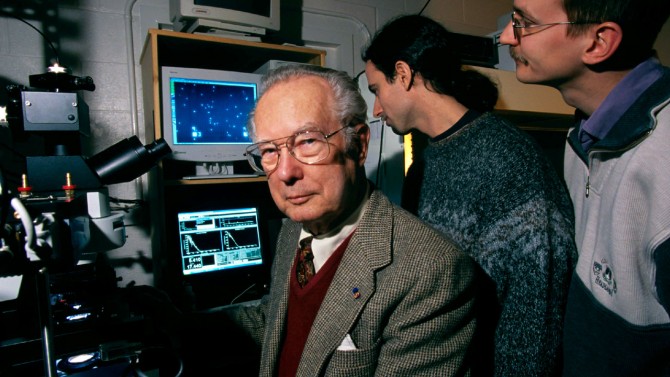Applied physicist Watt W. Webb, the S.B. Eckert Professor of Engineering Emeritus and a pioneer in methods for imaging living biological systems, died Oct. 29 in New York City. He was 93.
Webb was best known as the biophysicist who co-invented fluorescence correlation spectroscopy and multiphoton microscopy – imaging techniques that have revolutionized how scientists observe biological dynamics and structures deep within living tissue.
Watt W. Webb, the S.B. Eckert Professor of Engineering Emeritus and a pioneer in ways to image living biological systems, joined the Cornell faculty in 1961. He died Oct. 29.
Webb received his bachelor’s degree from Massachusetts Institute of Technology (MIT) in 1947. After graduating, he worked as an industrial engineer at Union Carbide.
In 1955 he completed a Sc.D. in materials science physics and mathematics, also from MIT. He returned to Union Carbide after MIT, but joined the Cornell faculty in 1961 as an associate professor of engineering physics. He was named professor of applied physics in 1965 and received the S.B. Eckert Professor in Engineering title in 1998. He served as director of the School of Applied and Engineering Physics from 1983-88. He retired from Cornell in 2012 as an emeritus professor.
Although the main focus of Webb’s early career was in engineering physics, he eventually became a member of the graduate faculties in seven fields. Later in his six-decade career, Webb advanced the study of basic biology. He had focused on multiphoton microscopy applications for use in medical diagnoses in living animals. Among his projects were noninvasive biopsies of tumors, and the imaging of damaged neurons in the brain that result from such diseases as Alzheimer’s.
Watt Wetmore Webb was born Aug. 27, 1927 in Kansas City, Missouri. As a child, he wrangled horses in southern New Mexico and spent time as a young man learning about the business world working at his father’s bank.
He entered MIT at 16. At MIT, Webb majored in business and engineering administration, but said he “didn’t study very hard.” He said he was more interested in competing on MIT’s championship sailing team and entering target-shooting competitions. Throughout his life, sailing remained a passion. He met Page Chapman, his wife of more than 60 years, sailing on the Charles River.
He then worked as an industrial engineer at Union Carbide, where he developed an automated submerged arc welding process, studied the theoretical strength of refractory transition metals and delved into superconductivity. Webb found he needed more science to tackle issues he faced at work, like measuring plasma temperatures. As a result, he returned to night school in 1952 and found a knack for studying. By 1955 he had completed with near perfect grades a Sc.D. in materials science physics and mathematics, also from MIT.
At Cornell, Webb’s first major achievement was to team with an undergraduate student, Malcolm Beasley, now an emeritus professor of applied physics at Stanford University, to develop the first stable superconducting magnet. This contributed to the development of magnetic resonance imaging – more commonly known as MRI – as well as nuclear magnetic resonance and other modern imaging techniques.
In 1969, Webb collaborated with Cornell chemistry professor Elliot Elson to invent fluorescence correlation spectroscopy, a technique that provides information about molecular processes that control living cells and their interactions with the environment.
Webb and colleagues realized early on that fluorescence serves as an excellent marker for tracking the molecules moving in cells and measuring molecular signaling in cells and tissues. This opened doors for much of Webb’s subsequent work in microscopic imaging of biological systems.
In the late 1980s, Webb and then-graduate student Winfried Denk, now a director at the Max Planck Institute of Neurobiology in Germany, invented multiphoton microscopy, which harnesses fluorescent markers deep in tissue for three-dimensional imaging.
The widely used technique produces high-resolution, 3D pictures with little damage to living cells by use of a laser that produces extremely short, intense pulses, sending two or three photons to a precise depth within the tissue.
Since patenting multiphoton microscopy, Webb worked tirelessly to bring the technique beyond basic science and into such areas as clinical diagnostics. He collaborated with doctors at Weill Cornell Medical College in New York City to use multiphoton microscopy in both cancer diagnosis and surgery, and to image damaged nerves in the brain that occur with such neurodegenerative diseases as Alzheimer’s and Parkinson’s. Webb and colleagues also moved toward creating “optical biopsies,” taking images of cells from deep within living animals without removing any tissue.
In 2017, the National Science Foundation awarded Cornell $9 million to establish the Cornell Neurotechnology NeuroNex Hub, which focuses on researching, developing and disseminating new optical imaging tools for noninvasive recording of neural activity in animals. The funding also established the Laboratory for Innovative Neurotechnology at Cornell, where engineers and biologists collaborate on developing and testing the tools. All of this work is based on Webb’s research.
Webb was elected to the National Academy of Engineering in 1993 and to the National Academy of Sciences in 1995. Webb was a Guggenheim Fellow, a fellow of the American Physical Society (APS) and of the American Association for the Advancement of Science, a founding fellow of the American Institute of Medical and Biological Engineers, and a member of the American Academy of Arts and Sciences, among other academic honors.
He won the APS Biological Physics Prize in 1990; the Ernst Abbe Lecture Award of the Royal Microscopical Society (UK) and Carl Zeiss (Germany) in 1997; the Michelson-Morley Award in 1999; the Rank Prize for Opto-electronics in 2000; and the Jablonski Award Lecturer in 2001.
Webb was predeceased by his wife, Page, in 2010. He is survived by sons Watt Webb III, Spahr Webb and Bucknell Webb; daughter-in-law Wendy Webb; and grandson Wiley Webb.
Anne Ju Manning is a former Cornell Chronicle science writer.








